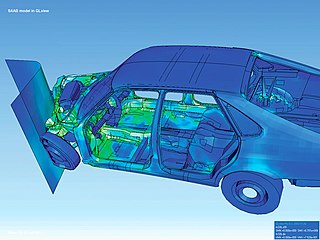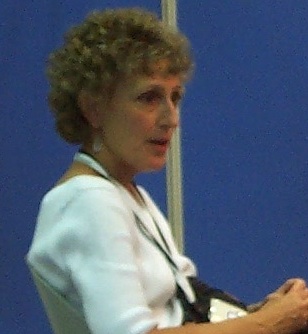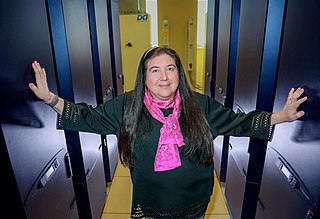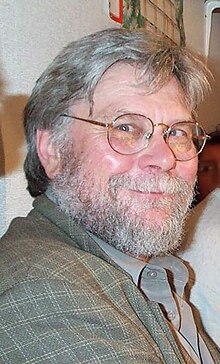GRASS is a programming language created to script 2D vector graphics animations. GRASS was similar to BASIC in syntax, but added numerous instructions for specifying 2D object animation, including scaling, translation and rotation over time. These functions were directly supported by the Vector General 3D graphics terminal GRASS was written for. It quickly became a hit with the artistic community who were experimenting with the new medium of computer graphics, and is most famous for its use by Larry Cuba to create the original "attacking the Death Star will not be easy" animation in Star Wars (1977).

Visualization, also known as Graphics Visualization, is any technique for creating images, diagrams, or animations to communicate a message. Visualization through visual imagery has been an effective way to communicate both abstract and concrete ideas since the dawn of humanity. from history include cave paintings, Egyptian hieroglyphs, Greek geometry, and Leonardo da Vinci's revolutionary methods of technical drawing for engineering purposes that actively involve scientific requirements.

A cave automatic virtual environment is an immersive virtual reality environment where projectors are directed to between three and six of the walls of a room-sized cube. The name is also a reference to the allegory of the Cave in Plato's Republic in which a philosopher contemplates perception, reality, and illusion.

The Sandin Image Processor is a video synthesizer, usually introduced as invented by Dan Sandin and designed between 1971 and 1974. Some called it the "video equivalent of a Moog audio synthesizer." It accepted basic video signals and mixed and modified them in a fashion similar to what a Moog synthesizer did with audio. An analog, Modular Synthesizer, real time, video processing instrument, it provided video processing performance and produced subtle and delicate video effects of a complexity not seen again until well into the digital video revolution.

A video synthesizer is a device that electronically creates a video signal. A video synthesizer is able to generate a variety of visual material without camera input through the use of internal video pattern generators. It can also accept and "clean up and enhance" or "distort" live television camera imagery. The synthesizer creates a wide range of imagery through purely electronic manipulations. This imagery is visible within the output video signal when this signal is displayed. The output video signal can be viewed on a wide range of conventional video equipment, such as TV monitors, theater video projectors, computer displays, etc.
Thomas Albert "Tom" DeFanti is an American computer graphics researcher and pioneer. His work has ranged from early computer animation, to scientific visualization, virtual reality, and grid computing. He is a distinguished professor of Computer Science at the University of Illinois at Chicago, and a research scientist at the California Institute for Telecommunications and Information Technology (Calit2).
The Electronic Visualization Laboratory (EVL) is an interdisciplinary research lab and graduate studies program at the University of Illinois at Chicago, bringing together faculty, students and staff primarily from the Art and Computer Science departments of UIC. The primary areas of research are in computer graphics, visualization, virtual and augmented reality, advanced networking, and media art. Graduates of EVL either earn a Masters or Doctoral degree in Computer Science.

PHSCologram is a registered trademark for barrier-strip and lenticular autostereograms made by Chicago-based art collective (Art)n laboratory.
Phil Morton (1945–2003) was an influential American video artist and activist who founded the Video Area in 1970 at the School of the Art Institute of Chicago, where he taught for many years.
Bruce Howard McCormick (1928–2007) was an American computer scientist, Emeritus Professor at the Department of Computer Science, and founding director of the Brain Networks Lab at Texas A&M University.

Maxine D. Brown is an American computer scientist and retired director of the Electronic Visualization Laboratory (EVL) at the University of Illinois at Chicago (UIC). Along with Tom DeFanti and Bruce McCormick, she co-edited the 1987 NSF report, Visualization in Scientific Computing, which defined the field of scientific visualization.
Larry Cuba is a computer-animation artist who became active in the late 1970s and early 1980s.

Carolina Cruz-Neira is a Spanish-Venezuelan-American computer scientist, researcher, designer, educator, and a pioneer of virtual reality (VR). She is known for inventing the cave automatic virtual environment (CAVE). She is a fellow of the Institute of Electrical and Electronics Engineers (IEEE), a member of the IEEE VGTC Virtual Reality Academy, a XR Hall of Fame member, a Modeling & Simulation Hall of Fame member, and a Spark Star of the Museum of Discovery. Currently, she is the Agere Chair Professor at the University of Central Florida (UCF).
Jane Veeder is an American digital artist, filmmaker and educator. She is a professor at San Francisco State University in the Department of Design and Industry, at which she held the position of chair between 2012 and 2015. Veeder is best known for her pioneering work in early computer graphics, however she has also worked extensively with traditional art forms such as painting, ceramics, theatre, and photography.

Ellen R. Sandor is an American new media artist. She is also founder of the Chicago-based (art)n, a collective of artists, scientists, mathematicians, and computer experts. Ellen Sandor and (art)n create sculptures that contain computer-generated photographic images that appear to be three dimensional. She is best known for combining computer graphics, sculpture, and photography to visualize subject matter that includes architecture, historical events, and scientific phenomena such as the AIDS virus, Neutrinos, Microglia, and CRISPR.

Franz Fischnaller is a new media artist and transdisciplinary researcher. He is recognized for the creation of his digital, virtual reality and interactive art installations works across the fields of art, technology, humanities and cultural heritage.
Barbara Sykes into a family of artists, designers and inventors. Since childhood, she has produced work in a variety of different art forms. In 1974, she became one of Chicago's pioneering video and new media artists and, later to include, independent video producer, exhibition curator and teacher. Sykes is a Chicago based experimental video artist who explores themes of spirituality, ritual and indigeneity from a feminist perspective. Sykes is known for her pioneering experimentation with computer graphics in her video work, utilizing the Electronic Visualization Laboratory at the University of Illinois, Chicago, at a time when this technology was just emerging. Her early works broke new grounds in Chicago's emerging New Media Art scene, and continue to inspire women to explore experimental realms. With a passion for community, she fostered significant collaborations with many institutions that include but are not limited to University of Illinois, School of the Art Institute of Chicago, Columbia College, Center for New Television, and (art)n laboratory. These collaborations became exemplary for the showcasing of new media work. The wave of video, new media and computer art that she pioneered alongside many other seminal early Chicago New Media artists persists as a major influence for artists and educators today. Her work has been exhibited internationally, at institutions such as Moderna Museet (Stockholm), Ny Carlsberg Glyptotek (Copenhagen), Musée d'Art Moderne de la Ville de Paris, Museum of Contemporary Art San Diego, Metropolitan Museum of Art , Museum of the Art Institute (Chicago), The Metropolitan Museum of Art and SIGGRAPH. Sykes's tapes have been broadcast in Sweden, Italy, Puerto Rico and extensively throughout in the US, including "The Independents", PBS national broadcast, 1985, and national cablecast, 1984. Media Burn has an online selection of her tapes and over 200 of her raw footage, master edits, dubs and compilation tapes in their Independent Video Archives @ Barbara Sykes https://mediaburn.org/collections/videomakers-page/barbara-sykes/. Select grants include a National Endowment for the Arts and American Film Institute Regional Fellowship, Evanston Art Council Cultural Arts Fund and several Illinois Arts Council grants. In 2017, Sykes began to paint. In 2020, as the recipient of an Evanston Art Center Individual Artist Exhibition Award, Ethereal Abstractions, Sykes's first solo watercolor exhibition premiered 81paintings and she gave an online Artist Talk. Her paintings are lyrical, colorful abstractions reminiscent of organic shapes, ethereal forms and underwater landscapes - evocative impressions of spiritual and elemental worlds. They evoke the spontaneity and themes that have evolved from her previous body of time-based and digital artwork. In 2021, she moved to Florida. Her 2022 painting exhibitions/reviews include Forces of Nature showcased on the cover of Estero Life Magazine and she is in the article, Beholding Beauty: Artists of Estero Exhibit at COCO Art Gallery, the Florida Watercolor Society's 2022 Online Show, the 36th Annual All Florida Exhibition and Connections Art in Flight exhibit at the Southwest Florida International Airport, June 2022 to June 2023. She paints under the name of Barbara L. Sykes.
Copper Giloth is a new media artist based in Amherst, Massachusetts. Giloth's work involves digital media, mobile art, virtual environments, animations, videos, painting, and installations, and have been influenced by elements of her life such as her parents. She, along with Darcy Gerbarg, helped organize art exhibitions that showed alongside the SIGGRAPH conference, marking the exhibitions as the first to be shown at the conference. Giloth has been described as "one of the leading exponents of computer art".
Bob Snyder is an American composer, sound and video artist, who lives and works in Chicago. His work focuses on the formal relations between electronic sounds and images, using synthesized visual and audio signals as his main medium. Throughout his career, he has worked extensively with Sandin Image Processor, and his work has been featured in two Whitney Biennal exhibitions as well as institutions like the Museum of Modern Art, New York, the New York Public library and the Art Institute of Chicago. Several of his works have been made in collaboration with the artists Phil Morton, Tom DeFanti and Dan Sandin. Snyder is also the founder of the sound department at the School of the Art Institute of Chicago in its present form, where he was Professor Emeritus from 2016(?) until his retirement in 2022 after forty-six years at SAIC. He is the author of the book Music and Memory published by the MIT Press . He is also the author of the "Memory for Music" chapter in the 2009 and 2016 editions of the Oxford Handbook of Music Psychology. In 2020, Snyder contributed a chapter entitled “Repetitions and Silences: A Music and Memory Supplement” to the anthology Composition, Cognition, and Pedagogy, published by the Brazilian Association of Cognition and Musical Arts. (ABCM).
Immersive learning is a learning method with students being immersed into a virtual dialogue, the feeling of presence is used as an evidence of getting immersed. The virtual dialogue can be created by two ways, the usage of virtual technics, and the narrative like reading a book. The motivations of using virtual reality (VR) for teaching contain: learning efficiency, time problems, physical inaccessibility, limits due to a dangerous situation and ethical problems.











